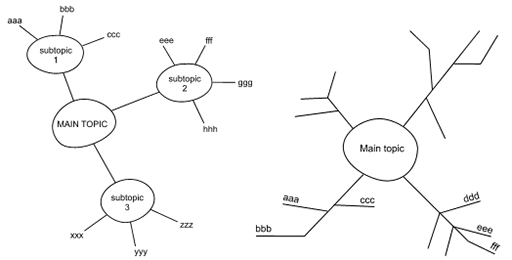Week 4 Guidelines
1 Spray diagrams (or mind maps)

Purpose
Spray diagrams and mind maps are similar to look at but have different functions. Both were developed by Tony Buzan (1974). They are included together here because their form and structure are almost identical if not their function.
Spray diagrams are mainly used for representing the structure of an argument, to encapsulate the relationships between the ideas of others or for note taking.
Mind maps, in contrast, are a little bit like brainstorming on your own, where you are trying to get your own ideas out on paper in a relatively unstructured way. They are a simple fast technique for getting ideas down without being concerned by details of structure. They can show connections in trains of thought (compare this with cognitive maps) and can indicate groupings between ideas or thoughts. They are less useful when there are lots of loops or cross connections to consider.
Elements
- central circle for main topic
- blobs for secondary topics (optional)
- words on the lines or at the ends of lines
- branching sets of lines
- title.
Conventions
- Put the keyword or phrase in a circle.
- Related ideas expressed in one or a few words are attached to lines radiating from this circle (a single-layer spray) or from secondary circles creating fans (multiple-layer sprays).
- Words may be written along the lines or at the ends of lines (e.g. aaa, bbb, ccc, etc.).
- The lines do not show directional links.
- Similar ideas on the radiating fans can be linked by loops.
- Different colours can be used to group or highlight particular fans or clusters of ideas.
Guidelines
- Use a large sheet of paper.
- It often helps to start near the centre of the page to allow the diagram to grow in any direction necessary. If you run out of space on the paper, add more sheets beside it and ensure you have plenty of space to work in.
- Write down the central idea you wish to explore, leaving space all around it.
- Identify a branch from that idea that you want to explore further. Write them down around the central idea and link each to it with a straight line. Keep going by considering each branch to see if further branches (ideas) link to it.
- Start by working fairly freely and then look at the diagram to see whether any of the strands are effectively the same idea.
- If you get stuck or lose the thread, start with a new central keyword and create a subsidiary spray diagram rather than clutter up the original. Alternatively, leave your spray diagram or mind map for a while to allow fresh thinking before adding to it or redrawing it, combining or grouping similar ideas.
